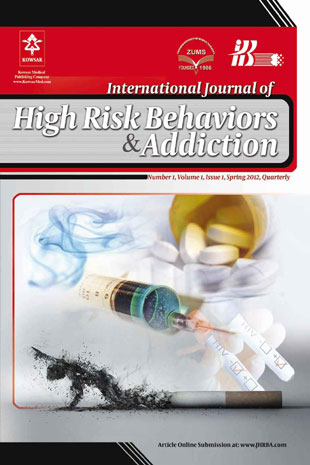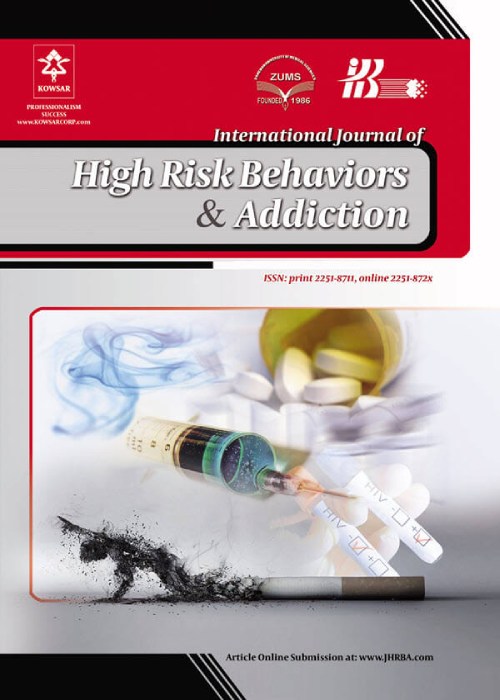فهرست مطالب

International Journal of High Risk Behaviors and Addiction
Volume:1 Issue: 2, Jun 2012
- تاریخ انتشار: 1391/07/11
- تعداد عناوین: 11
-
-
Page 50BackgroundPrimary maladaptive schemas, which are the basis of high-risk behavior and psychological disorders, result from childhood experiences with significant objects, such as fathers, in different developmental phases.ObjectivesThis endeavor examined the role of the father in predicting these schemas.Patients andMethodsA total of 345 Islamic Azad University students (Qom Branch) who were chosen through convenience sampling completed the Young Schema Questionnaire, the Parental Bonding Instrument, and the Parent–Child Relationship Survey.ResultsA multivariate regression analysis indicated that anumber of aspects of the father–child relationship, including care, emotional interaction, positive affection, the effective relationship, and excessive support, predict particular schemas.ConclusionsTherefore, these findings suggested that psychotherapists examine the different aspects of the father–child relationship when restructuring schemas.Keywords: Paternal Behavior, Father, Child Relation
-
Page 55BackgroundThe mental health and dyadic adjustment of smokers is a matter of serious concern which brings many demerits on mental health as well as physical heath.ObjectivesThis study was performed to ascertain the relationship between mental health and dyadic adjustment of smokers and nonsmokers in Zahedan.Patients andMethodsThe sample size consisted of 100 smokers and 100 nonsmokers selected through accessible sampling method. The General Health Questionnaire-28 (GHQ-28) and Dyadic Adjustment Scale (DAS) were used to collect the data. Pearson correlation, stepwise regression, and independent “t-test” were applied to analyze the data.ResultsResults revealed that physical symptoms, anxiety, social dysfunction, and depression sub-scales, as well as total scores of mental health negatively correlated with dyadic adjustment. Stepwise regression showed the followingResultsin the total sample, physical symptoms accounted for 22.7% of the variance in dyadic adjustment; also in the total sample, physical symptoms and social dysfunction together explained 24.5% of the variance in dyadic adjustment; social dysfunction accounted for 30%, anxiety for 3.7%, depression for 7% and overall mental health for 3.5% of the variance in dyadic adjustment in the smokers’ sample. Results demonstrated that physical symptoms explained 15.9% of the variance in dyadic adjustment in the nonsmokers’ sample. Results further revealed that the mean scores of physical symptoms and anxiety sub-scales, and the total scores of the mental health of smokers were greater than those of nonsmokers. However, no significant differences appeared between the two groups on social dysfunction and depression. Finally, the research revealed that the mean scores of dyadic adjustment were greater for nonsmokers than for smokers.ConclusionsThe research revealed that nonsmokers showed better mental health and dyadic adjustment than smokers, thus suggesting that smoking endangers and can impair the tranquility of families and that smoking also threatens the dyadic adjustment of couples..Keywords: Mental Health, Psychiatric Status Rating Scales, Smoke
-
Page 61BackgroundThe way that people explain events may influence aspects of their development and health. A number of studies have reported that there is a positive relationship between pessimism and the risk of poor heath, infectious disease, and early mortality.ObjectivesThis study was conducted to examine the effectiveness of an optimism skills group training (OSGT) on the attribution styles of delinquent boys.Patients andMethodsA quasi-experimental method with a two-group design was used, with random assignment and pre- and post-tests. The subjects were selected from adolescent boys, aged 13 to 18 years, in the Kerman Juvenile Correction and Rehabilitation Center (KJCRC). The participants were allocated to two matched groups based on their pre-test scores. They were assigned randomly to the control and experimental groups. The sample comprised 61 boys. Optimism Skills Group Training (OSGT) was conducted with the experimental group during 10 sessions. Then the subjects were administered the post-test, with a follow-up test a month later. Statistical analysis was conducted using the t-test and repeated-measures analysis of variance. The research instrument was the Attributional Style Questionnaire (ASQ).ResultsThe results showed that the OSGT changed the attributional styles of delinquent boys from pessimistic to optimistic. Also, the follow up study showed that the effect on the delinquent boys’ attributional style was still present after one month.ConclusionsEven though the OSGT is an effective technique for inculcating an optimistic attribution style in delinquent boys, this important method needs to be continually implemented in their education.Keywords: Attribution Styles, Rehabilitation, Juvenile Delinquency
-
Page 66BackgroundLithium is a drug for treatment of bipolar disorder by correcting mania and reducing depressive mood swings.ObjectivesIn this study, effects of Lithium on volumetric parameters of cerebellum were investigated using stereological methods.Materials And MethodsIn this experimental study, 20 sexually mature wistar male rats were selected and divided in two groups randomly (n = 10). Administration and control groups received continuously 0.1 percent Lithium carbonate solution and distilled water respectively with drinking water during a period of 12 weeks. Rat’s cerebellum excised and fixed in modified Lillie’s solution. Then tissues were dehydrated, cleared, and embedded in paraplast in random orientation, and exhaustively sectioned. Ten to twelve sections of ~ 5μm were sampled and stained from each cerebellum by systematic uniform random sampling. The whole section image projected on the table, and using Cavalier’s principle point-counting was employed to estimate the volumetric parameters. Data analyzed by nonparametric statistical test of Mann-Whitney, and differences between groups less than 0.05 considered significant.ResultsThere were no significant difference in terms of total volume but gray matter volume of cerebellum increased and white matter decreased in administration group significantly (P < 0.05).ConclusionsAdministration of 0.1% Lithium carbonate for a period of 12 weeks can affect cerebellar gray and white matters in rat.Keywords: Lithium, Cerebellum, Bipolar Disorder
-
Page 71BackgroundThe association between smoking and tuberculosis (TB), which has been proven in multiple studies with different study population ethnicity, has not yet received sufficient attention in terms of TB control.ObjectivesThe aim of the present study was to determine the association between TB and cigarette smoking in southeastern Iran, an endemic area for tuberculosis.Patients andMethodsThis prospective case-control study conducted at a University-Affiliated Hospital (Boo-Ali Hospital, Zahedan, and Southeastern Iran) from March 2007 to March 2012 enrolled 253 TB patients and 312 healthy controls. Factors including history of cigarette smoking, duration of smoking, number of cigarettes smoked per day, consumption of other drugs (parenteral and non-parenteral), and family history of tuberculosis and smoking, were evaluated in both cases and controls. Univarate and multivariate logistic regressions were performed to compare TB cases and controls. The odds ratio (OR) and 95% confidence intervals (CI) were also estimated.ResultsThe results of the study revealed a significant difference between TB and control groups in relation to smoking (P < 0.0001). In multivariate logistic regression, cigarette smokers were 3.1 (95% CI: 1.4-10.3) times more frequent in TB patients compared with controls. Other factors that showed significant differences between TB patients and controls were the use of non-parenteral drugs (OR = 3.6, 95% CI: 2.2-21.4), family history of TB (OR = 6.6, 95% CI: 2.3-18.2), family history of smoking (OR = 2.8, 95% CI: 1.1-8.4), and smoking history of more than 10 years (OR = 1.6, 95% CI: 1.2-9.8).ConclusionsThe present study evidenced the association between TB and smoking. It is therefore recommended to include interventions for smoking cessation in the current TB control practice.Keywords: Tuberculosis, Smoking
-
Page 75BackgroundThe increasing use of mobile phones in recent years has caused concerns about the effects of electromagnetic waves of mobile phonesonhuman biological processes.ObjectivesThis study was conducted in order to survey the effects of mobile electromagnetic waves on electro cardiogram parameters as heart rate، TP segment، PR interval، Time of QRS and T waves، and voltage of R wave. Patients andMethodsIn this quasi experimental study، 40 students، of Zahedan medical science University، 20 boys and 20 girls، who had referred to the laboratory of physiology were selected. At first a normal electro cardiogram in lead I was recorded for each of the subjects for 20 seconds. Then a mobile phone was placed near their body and while mobile was ringing and talking two other electrocardiograms were recording for 20 seconds. Electro cardiograms were recorded with power lab device and analyzed by chart 5 software. Finally an ANOVA was employed to analyze the data through the SPSS 17، followed by a Tukey testResultsThere was significant difference between heart rate during talking in comparison with heart rate during ringing and resting in both genders. There was a significant decrease of resting TP segment in comparison with TP segment during ringing and talking in males whereas in females TP segment indicated significant difference in all three conditions. There was a significant increase in T wave time in males during talking in comparison with resting and ringing; however there was no significant difference in that of females in any of the three stated conditions. This study revealed that there is not any significant difference in PR interval، Time of QRS wave and R wave voltage.ConclusionsAccording to the results of this study، mobile phones can affect the heart rate، TP segment and time of T wave. Therefore، it seems that long term use can affect heart. Based on several reports on the effects of these waves on biological processes، precautionary measures should be taken about using mobile phones.Keywords: Mobile Phone, Electrocardiogram, Students, Iran
-
Page 79BackgroundCoronary Heart Disease (CHD) is one of the most common and life-threatening diseases in both developed and developing countries and a close correlation has been found between different types of obesity and CHD.ObjectivesThe current study investigated the relationship between central obesity and coronary heart disease risk factors in CHD referral outpatients to Khatam Clinic, Zahedan, Iran.Patients andMethodsIn this clinical, cross-sectional study, data for 120 CHD patients aged 30–60 years were included. Based on waist-to-hip ratio (WHR), subjects were classified into two groups: not centrally obese (NCO; WHR ≤ 0.95 for men, ≤ 0.8 for women) and centrally obese (CO; WHR > 0.95 and > 0.8 for men and women, respectively). Triglyceride (TG), total cholesterol (TC), blood urea nitrogen, creatinine, and fasting blood sugar (FBS) were enzymatically determined. Sitting systolic and diastolic blood pressures were measured for each patient.ResultsSignificantly more women than men and significantly more subjects with less education than subjects with more education were CO. Rates of CO were higher in subjects 45–60 years old than in those 30–45 years old (n.s.). CO subjects also had higher mean systolic and diastolic blood pressure, TG, and creatinine levels (n.s.). Significantly higher mean values were observed for FBS in CO subjects than in NCO subjects (P = 0.02). Mean values for smoking were significantly higher in the NCO group compared with the CO group (P = 0.004).ConclusionsAccording to the results of this study, in CHD patients, central obesity was associated with certain risk factors, especially FBS. Central obesity was more evident in women, less educated subjects, and older subjects. Further research is required to clarify these associations..Keywords: Central Obesity, Coronary Artery Disease, Risk Factors, Iran


